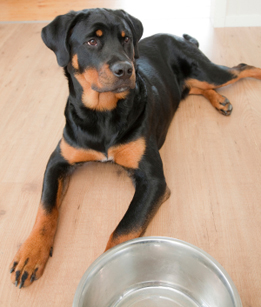How to Change Dog Food
July 05, 2012 | By David Jackson, AllAboutDogFood.co.uk
We all need to change our dog's diet from time to time. Whether it's because of a problem with the current food, because you're going on holiday and need a more convenient option, because he's getting older and needs to move to adult or senior food or simply because you think he'd like something new, whatever the reason, food changes are part and parcel of owning a dog. The problem is that, for many of our dogs, changing foods is the first step on the road to the vet with digestive upsets. But it doesn't have to be that way! Follow these simple rules and changing your dog's food will be as easy as 1, 2, 3...
 1. Take your time 1. Take your time
If your dog has been on a single food for a while, the digestive system will need time to adjust to any change. This is because the dog's body is able to adapt its enzyme production depending on what types of foods are being eaten. The enzymes produced when they eat, say, beef and rice would be quite different from the enzymes produced to digest fish and vegetables. Over time though, the dogs body can get used to producing a certain range of enzymes for a single diet and when the food changes unexpectedly, the dogs body can be left totally unprepared and unable to cope. However, if the new food is introduced slowly, the body will have time to adjust and begin producing the right enzymes for the job.
We always recommend introducing a new food over several days to make the change as easy as possible on the dogs system. The easiest way would be to start by feeding 75% of the old diet with 25% of the recommended feeding amount of the new food for a day or two. This can be followed by 1-2 days at 50/50 and for the last couple of days feed 25% of the old food with 75% of the new before moving completely onto the new food. For dogs with sensitive stomachs, you should extend this schedule to last 7-10 days to really minimise the chances of any problems.
Changing between different varieties of the same range can usually be done more quickly as many of the ingredients will be the same.
2. Get the amounts right
It is important to realise that different dog foods can have dramatically different feeding amounts and that too much of any food can cause digestive problems. Low-grade foods, for example, tend to contain large amounts of fillers so, to get enough nutrients, dogs need to eat quite a lot. High end foods, on the other hand, are packed with highly digestible, highly nutritious ingredients so dogs need very little to get everything they need. One mistake I see all the time is when an owner changes their dog from a low to a high-quality food but carries on feeding the same high amount. The dog inevitably gets overloaded with so much of the new food and becomes ill and the owner concludes that good foods don't agree with their dog.
Before starting the change on to any food, make sure you read the label and work out roughly how many grams your dog will need. You can then use that figure for calculating the correct proportion of the new food throughout the change.
3. And that's it!
OK, so it's actually as easy as 1, 2, but that's not quite as catchy. As long as you take it slowly and don't overfeed, the change should go without a hitch. Keep an eye on your dog's stools (my favourite hobby!) as they are the best indicators of the internal health. If they start getting soft, don't worry, it probably just means you're moving too fast so go back to the last ratio that worked, slow the change down and try again.
And it really is that easy... usually. Of course, if you have any questions or doubts along the way, or if you have any other tips for ensuring a smooth dog food change, please let us know.
|
J Purcell •one year ago
Hi. I am trying to transition my 12 mnth standard poodle to a new food as not keen on old food. She has a sensitive tummy anyway hence changing food. As advised by vet. Trouble is. She will pick out new food and leave the old food! So transition hard. Not eating old food !! Any advice?Alana K J Purcell
•one year ago
J Purcell
•one year ago
Yes, I agree, difficult when they don't eat their original food! However, there's not much to suggest apart from persevering/going straight to new food (if she's not eating the old food anyway!). The only other thing I can suggest is adding a good probiotic to support gut health while transitioning and for a while afterwards. You can add Kefir (especially goats kefir) or a probiotic supplement. The best ones in my opinion are Kiki Health Body Biotics (cheapest I believe), Adored Beast Love Bugs or Healthy Gut, and Four Leaf Rover Protect or Digest. Alana xMary Hunter •one year ago
Hi I have a 6 yr old Golden Retreiver. She has been with us for only 4 mths - she is a rescue dog & was used for producing puppies. When we got her she had just been spayed. I feed her one tin Chappie Original as I was advised by kennels to do (divided into two meals) together with roughly about 140 grms Burns Adult Chicken & Brown Rice each time. I am conscious she is putting on weight but don't know if this is due to her change in lifestyle or if I am feeding her the wrong food. Can anyone advise me on this or give their thoughts. Thanks - any help will be welcome.